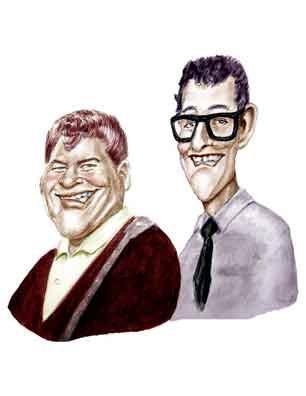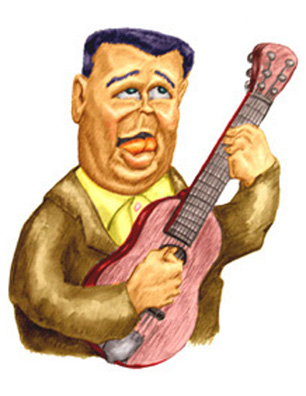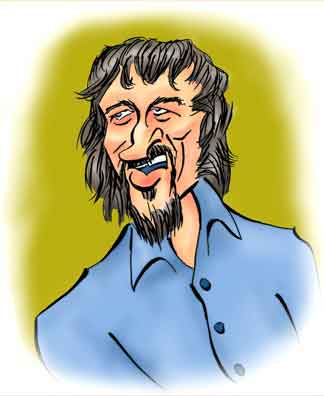Ritchie Valens and Buddy Holly
(And the Big Bopper)

Richard Steven Valenuela
Charles Hardin Holley
(Yes, Buddy's real name was spelled with an "e".)
"You know what I think of that abomination, rock and roll? I think it is a disgrace! Poison put to sound! When I hear it I feel very sad, not only for music, but for the people who are addicted to it. I am also very sorry for America."
- Pablo Casals, ca. 1956.
Given how rock and roll was held in such horror in its beginnings, particularly by bald-headed cello players, it comes as a shock to hear what good musicians some of the early rockers actually were. Which is a good thing since neither Ritchie nor Buddy had the traditional teen-idol looks of Frankie Avalon or Fabian.
By 1959 rock (then always called rock and roll) was a big, if not quite respectable business. Financially it was the producers who were raking in the dough. Many of the performers, at times even the stars, were struggling financially. Paul Evans, who had the (to him) surprise hit "Seven Little Girls (Sitting in the Back Seat)" remembers that when he went on tour all expenses came out of his royalties. Even then it could be a battle to collect royalties at all, and any share of door receipts for a concert or tour might barely cover expenses.
The bright side (if you want to call it that) is the fans didn't have to shuck out of $195 for a ticket to barely see a set of gyrating, anorexic ladies lip syncing their lines into ear mikes. To see Buddy and Ritchie all you had to pay was $1.25 - cheap even by the standards of the day. So on Friday night the kids would troop down to the local VFW hall for the weekly sock hop. For the extravaganzas like the "Winter Dance Tour" of Buddy and the others, the bands might play in grandly named "ballrooms", small town versions of today's convention centers and were generally large cavernous buildings that could hold at up to two thousand people.
Buddy and Ritchie are now part of the American mythology, and so urban legends abound. No, Ritchie did not have a phobia against flying. In fact, he wanted to take the plane from the Mason City Airport. Other (false) stories are the plane on their final flight was named "American Pie", and the height of absurdity, that Buddy shot the pilot.
But it is true that Buddy had a bass player who could barely play and was also slated to take the flight. But this gentleman chivalrously gave up his seat to Jiles Perry Richardson, J. P. to his friends and "The Big Bopper" to his fans. Buddy's neophyte bass player was, of course, Waylon Jennings.
The Big Bopper had begun as (and at the time still was) a radio DJ from Beaumont, Texas. But he was also a performer of considerable merit and had scored a surprise hit with his comedy/novelty song, "Chantilly Lace" although as yet he had not seen a penny in royalties. But now the Bopper had a cold and asked Waylon if he could take his place on the plane so he wouldn't have to ride in the group's unheated bus. Waylon said it was fine with him if it was OK with Buddy.
What caused the crash has been debated ever since the day it happened. But the background cause is well known. In short, it was because the bus they had been using was barely suited for travel. The heater wasn't working and at one point one of the troop was hospitalized for frostbite. Then the bus broke down in the middle of the night. Only those who have had the joys of traveling in Northern Iowa in the middle of winter (a first hand CooperToons experience) know what this means. The tour literally could have frozen to death if it wasn't for the fact they flagged down passing cars. Gradually by twos and threes they were ferried by the Good Samaritans of Iowa into the nearest town.
So it's not surprising that after the tour got to Clear Lake, Buddy decided he and the two other members of his band, Waylon and lead guitarist and backup singer Tommy Allsup, would rent a plane and fly to the next gig in Moorhead, Minnesota - total cost $108. Waylon had agreed to let the Big Bopper go in his place, and Ritchie asked Tommy if they could trade places. Tommy said no, but Ritchie kept pestering him throughout the night. Finally just before Tommy, Buddy, and J. P. were about to leave, Ritchie once more asked Tommy to trade places. For some reason, Tommy said if Ritchie wanted to go on the plane so much, they would flip a coin. Ritchie said OK. Tommy pulled out a coin and flipped. Ritchie called heads, and heads it was. "Well, Ritchie," Tommy said. "This must be your lucky day."
Shortly after midnight on February 3, 1959, Buddy, Ritchie, and J. P. stowed their luggage on the plane at the Mason City airport. Then with the 21 year old commercial pilot Roger Peterson at the controls, they taxied to the runway. After a pause of a few minutes, they took off.
As far as the immediate cause, "pilot error" was the finding of the Civilian Aeronautics Board investigators. However, the report had a distinctly negative tone of hindsight omniscience that is somewhat contradicted by what's in the report itself. On the one hand they trash Roger as "unwise" for taking off in conditions that would require sole instrument flying (which he wasn't certified for) and for not obtaining full information about the deteriorating weather conditions. At the same time they acknowledge Roger was told all stations were reporting ceilings of 5,000 feet or better, and visibility was at least 10 miles. The owner of the charter company also said he saw nothing that would preclude Roger flying. Roger himself had about 50 hours of nighttime experience and was told that the front (which would bring the bad weather) wouldn't arrive for another four hours. Based on what he was told, there was no reason why Roger thought he couldn't make the trip safely.

Jiles Perry Richardson
The Big Bopper
So the story you hear that they took off in a - quote - "blinding snowstorm" - unquote - is false. Yes, the weather farther north was getting worse, but certainly in northern Iowa virtually no snow fell that night (reports said it was "a trace"). Claims that there were four inches of snow on the ground the next morning are not borne out by the photographs. Although the patches of grass in the field gave an appearance of depth, there was barely a covering on the ground itself. Another - quote - "legend" - unquote - arising out of the imagination of the scriptwriters of the Buddy Holly Story is that the bus broke down (again?) before they were going to leave for Moorhead. So Buddy decided to fly. But this scenario just isn't true. The bus, although having not proven itself very reliable, was in working order, but Buddy wanted some extra time to do his laundry.
That doesn't mean there were not weather related problems, of what are now called micro-weather phenomenon. Although the night was generally clear, there were gusty winds and periodic snow showers. The showers were brief but heavy and could cut visibility close to zero. Also when the four men took off from the airport and turned north, they left the well-illuminated Mason City and moved over the Iowa countryside. At that point with the overcasts skies and few ground lights, it would be common for a pilot to lose the horizon as it's called. For a pilot not certified for non-visual flying that could be a problem. Also another potential point of confusion is that on a Beechcraft Bonanza 35, the autogyro, which indicates the aircraft's pitch, worked in a manner opposite to the planes that Roger was most familiar with.
In the end, no one knows what really happened. But based on the circumstances and what three witnesses said, here is a scenario which seems reasonable. It is more or less what we learn from journalist Larry Lehmer's book The Day the Music Died: The Last Tour of Buddy Holly, Ritchie Valens, and the Big Bopper, although perhaps not exactly.
First there's a distinct possibility that Roger did have concerns about taking off that night. When he got to the runway the plane sat for several minutes. There's speculation that he was having a discussion with Buddy on that very point. Buddy, who had absolutely no fear of flying (and in fact hoped to get a pilot's license), may have pressed him to leave so they could make their gig. In any case, take off they eventually did.
When the plane left the ground, Roger was heading south and turned left, making a more than 180 degree turn. He gained altitude west of Mason City and then headed northwest. At that point we can surmise he had trouble orienting himself and may have resorted to using the Bonanza autogyro, an instrument which it must again be mentioned, worked in reverse of what he was used to. That would explain what Roger's boss, Jerry Dwyer, saw. As Jerry watched the plane reach about 800 feet and continue northwest, he thought the plane appeared to begin a slow descent. But he put it off as an optical illusion.
It was about four miles north of the airport that Roger encountered a snow shower. This would have masked the fact he was actually heading downward. Realizing that he couldn't see where he was going, he turned on his landing lights, which as anyone knows who's driving through a snow squall knows, doesn't really help.
That snow was falling at that time and place is confirmed by a witness - who coincidentally was the most important witness we have. It was none other than the lady whose house Roger was about to plow into. She had been working late at night on painting her kitchen. As she was just packing up and getting ready for bed, she heard the noise of the plane. Peeping out her window, she saw what you normally look for only in disaster movies: the landing lights of an airplane headed directly toward your house. Thinking about as fast and clearly as anyone could under the circumstances, she immediately hit the outdoor flood lights and ran outside to get out of the path of the plane.

Waylon Jennings
Buddy's Neophyte Bass Player
(Then)
With the sudden flash of light, Roger immediately pulled up and passed over the house only to skirt close to another house which also had a light streaming out a side window. He veered to the left, and in an attempt to recover from his evasive turn, he quickly cut to the right, hoping to gain altitude. But at that point he was literally skimming over the surface. The plane clipped its right wing on the ground and smashed into the field at 165 miles per hour. Five hundred feet later it came to a stop, a balled up mass of metal resting next to a barb wired fence.
No one in the houses heard the actual crash. In fact they thought the plane had pulled up and flown off. It wasn't until 9:30 that morning that Jerry, not hearing anything from Roger, had taken to the air and spotted the wreckage. Ritchie, Buddy, and J. P. had all been thrown from the plane while Roger was still tangled in the metal mass.
(Note: The non-squeamish can read the official coroner's reports if they click here. To read the final Civil Aeronautics Baord report, click here.)

... and Now.
It's ironic that only one of the passengers, Buddy Holly, had been slated for the flight. Even more ironically, the bus ride north for the rest of his band had been comfortable and warm.
But the final irony is the conversation Waylon and Buddy had after Waylon had given up his seat to the Big Bopper. When the show was over, Waylon had seen Buddy sitting on a cane chair eating a hot dog.
"So you're not going with us tonight on the plane, huh?" Buddy laughed, "Well, I hope your ol' bus freezes up."
"Well," Waylon replied, giving Buddy some of his own, "I hope your old plane crashes."
Waylon said that bothered him for a long time.
Further Reading.
A major source for this essay is The Day the Music Died: The Last Tour of Buddy Holly, Rictchie Valens, and the Big Bopper by Larry Lehmer (Schrimer Books, Simon and Schuster, 1997). This is a well researched book, and although it does not shirk discussing the controversies, it remains objective and realistic.
The report of the Civil Aeronautics Board is reproduced full in Larry's book and can also be found on-line at various places, particularly "The Day the Music Died" at The Fifties Web at http://www.fiftiesweb.com/crash.htm.
There you can also read the coroners report on Buddy (as you can from the above link). Although no full autopsy was done on any of the passengers (although it was for Roger), the reading is still a bit gruesome. Not only that, but you read that the coroner, Ralph Smiley, relieved the dead Buddy of $11.65 out of the singer's pocket for the "coroner's fee". Legitimate? Yes, and probably the normal procedure, as to his credit Raph wrote the transaction down. But it strikes the average reader as faintly tacky and is remniscent of Judge Roy Bean, also acting as coroner, fining a dead man $40 for carrying a concealed weapon.
It is hoped that Mr. Lehmer will also not mind a CooperToons borrowing of his literary device of using Pablo Casals' sputtering indignation at rock and roll as a header. It's too good to pass up. Actually, the quote in the book was not exactly the same one used here. But the sentiment is the certainly the same. Pablo gave his famous rock-is-destroying-America diatribe to Time Magazine.
Pablo also predicted that rock and roll would pass away, something that many other mainstream musicians also believed - or at least hoped for. (Elvis, by the way, was a bit worried about that himself). But we shouldn't be too hard on Pablo. Recognizing that the music of the young may have merit is almost impossible for the older generation. It just takes time.
The version of the last conversation that Waylon had with Buddy is that given by Waylon himself in an interview in 1999 on Country Music Television. It was repeated in a tribute to Waylon on CMT February 2002. Originally it appeared at http://www.cmt.com/artists/news/1452295/02142002/holly_buddy.jhtml but the link is no longer active. Similarly Tommy Allsup has related the story of the coin toss with Ritchie in interviews.
An interesting article about the last episode of The Big Bopper was published recently in his hometown paper, the Beaumont Enterprise. The original URL (which unfortunately is also no longer active) was
http://www.beaumontenterprise.com/site/news.cfm?newsid=18065828&BRD=2287&PAG=461&dept_id=512588&rfi=6
However, a web search at this time did find some stories about the exhumation.
The story was not for the squeamish and covered the exhumation of the Big Bopper and the subsequent forensic examination to put to rest the story Buddy shot the pilot (which, of course, he didn't). The tests were not, it should be emphasized, due to some author trying to push a book as has been done in the past for other such cases. Instead, the Bopper's grave was being moved to a location more accessible for visitors, and his son (who was born shortly after J. P. was killed) decided to request the examination. So that's fine.
J. P., Jr., by the way, looks remarkably like his dad and even performs under the name, Big Bopper, Jr.